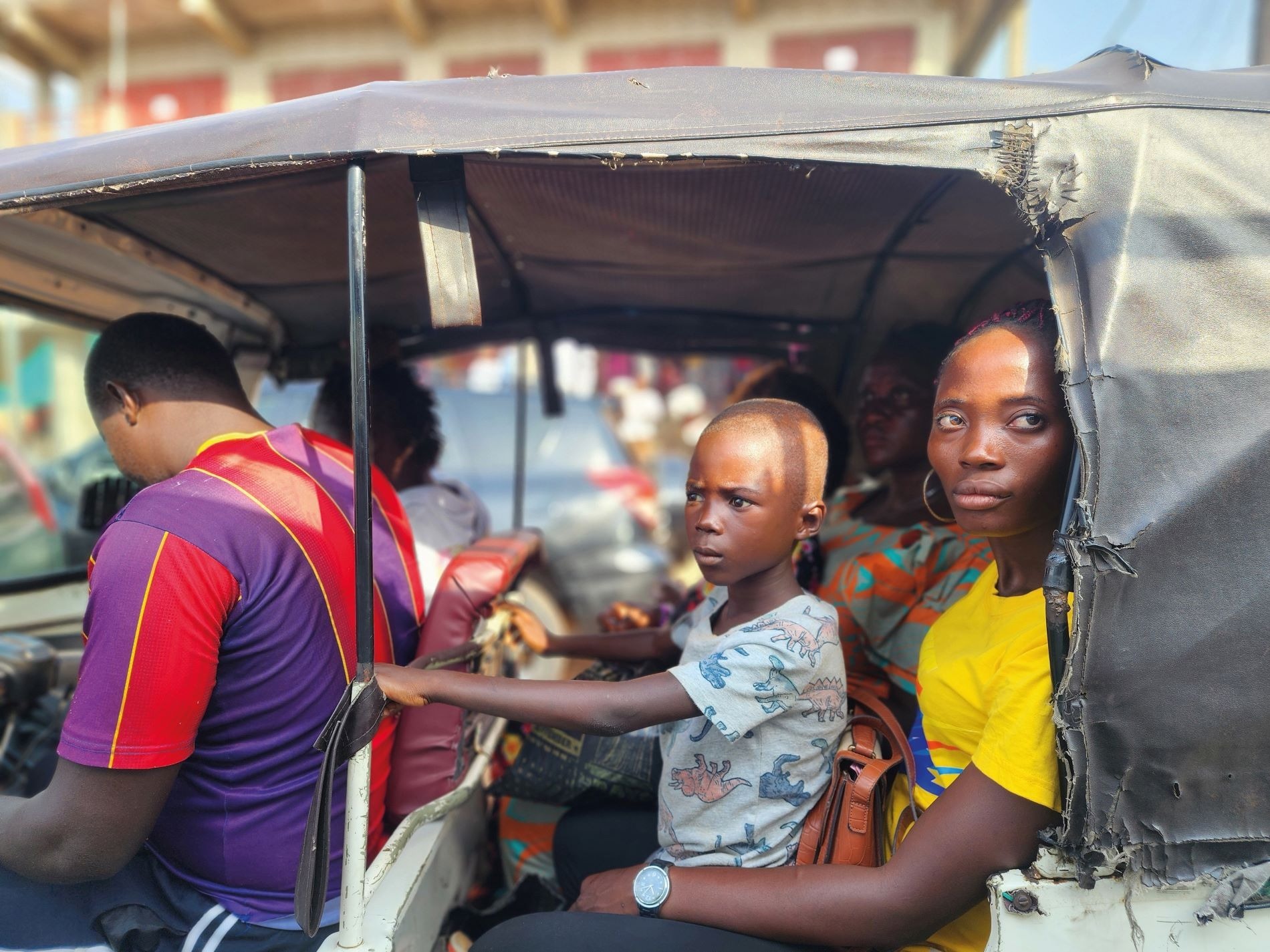New vaccines offer hope in the fight against one of the world’s deadliest diseases

It’s the start of the rainy season in Sierra Leone, the west African country known for its beautiful beaches and tropical rainforests. The coming of the rains brings relief from the heat, but also something else: mosquitoes. While Sierra Leone suffers all through the year, the rainy seasons are the worst for mosquito-borne diseases.
The mosquito is responsible for more deaths worldwide than any other animal – more than snake bites or even homicides. The winged insect carries diseases like Dengue fever, Zika virus and, of course, malaria. There were 249 million malaria cases and 608,000 deaths in 2022, according to the World Health Organization (WHO). Africa shoulders by far the heaviest burden, with 94 per cent of cases and 95 per cent of all deaths.
Throughout Africa, malaria is a serious threat to older people, pregnant women, children, and those with weakened immune systems. In Sierra Leone, it accounts for a quarter of all child deaths. But this year, the president gave the country hope that the disease would finally be contained. On World Malaria Day in April, President Julius Maada Bio launched a landmark malaria vaccination campaign, initially targeting babies. Since then, the Ministry of Health, working alongside the United Nations body Unicef, has been busy rolling out the first 550,000 doses to the furthest corners of Sierra Leone.
The vaccine, RTS,S (commercially named Mosquirix), is made by the British pharmaceutical company Glaxo-SmithKline. As part of pilot programs in 2019, it was delivered to more than two million children in Ghana, Kenya and Malawi and subsequently became the world’s first malaria vaccine to receive prequalification from WHO, meaning it has been assessed for quality, safety and efficacy. It was found to prevent around 75 per cent of all malaria cases in high-transmission areas where children were also given seasonal anti-malarial medicine when the risk was highest. This prompted WHO to recommend widespread use of the vaccine among children in sub-Saharan Africa.
Sierra Leone is one of the first countries to begin a nationwide rollout, alongside Cameroon and Burkina Faso. Ghana, Kenya and Malawi are also due to get more doses following the pilot programs, along with Benin and Liberia. While this is cause for celebration, the vaccine still has its limitations. Unlike other routine immunisations, this malaria vaccine requires four doses to achieve long-term protection. The shots must be stored at certain temperatures – a challenge for areas with regular power outages or no electricity at all.
Sierra Leone is planning to deliver the vaccine to 15 of its 16 districts. It’s an ambitious plan for a coastal country with remote and island communities, some of which can only be reached by motorbike or boat. But if the rollout is successful, it may provide a model for other African countries. It is not only a tragedy that so many children and vulnerable people die each year from this preventable disease; malaria has also held these countries back from crucial economic development. An effective, scalable vaccine would be a huge boon for the future of the continent.
Decades in the making
Given the large-scale and devastating effects of the disease, why has a malaria vaccine taken so long to develop? Malaria is caused by a parasite called Plasmodium, which infects female mosquitoes after they have fed on the blood of an infected human. Malaria parasites enter the human bloodstream and in serious cases can cause irreparable damage to the liver, kidneys and other organs. After maturing, the parasite infects red blood cells, destroying the body’s ability to supply oxygen to its tissues, leading to anaemia. Infected blood cells can clog up the circulation leading to organ failure and death.
Development of a vaccine began in 1987 through a partnership between GlaxoSmithKline and the Walter Reed Army Institute of Research, run by the US Department of Defense. But there were multiple challenges in developing a vaccine with effective, long-lasting immunity. The mosquito has a complex life cycle and high genetic diversity, with over 3,000 species currently recorded, varying in their capacity to transmit different strains of the malaria parasite. This led to difficulties in creating a vaccine that would be effective across different countries and regions. It was not until 2019 that Mosquirix was deemed ready for major clinical trials.
Dr Desmond Kangbai is one of the civil servants leading the vaccine rollout in Sierra Leone. In a gloomy government office in the bustling capital of Freetown, he takes calls from several phones on his desk, while aides shuffle in and out. It’s hot and humid, and several fans flutter the corners of papers stacked into wobbly towers on his desk. Dr Kangbai leads the Ministry of Health’s Expanded Program of Immunisation. He’s stressed, but also hopeful about the rollout’s prospects. “It could be a silver bullet,” he says, wiping his brow. “But we do need more resources.”
The government is initially focusing on delivering the vaccine to young children. All babies and small children are more vulnerable to malaria, with their immune systems still developing, but in Sierra Leone there is the added challenge of malnutrition. Meanwhile, keeping children free of mosquito bites can be an impossible task. This means that the constant threat of death hangs over families with babies and young children. Sierra Leone’s under-five mortality rate is one of the highest in the world.
The program has identified around 1.5 million children under the age of five who need the vaccine, but only currently has enough doses to give the jab to one-third of them. Distribution is also an issue, particularly reaching far-flung rural areas. Dr Kanbai explains that the program needs more funding and resources for everything “from coaching [of medical staff and unpaid volunteers] to refrigerators, boats to reach river and island communities, and to cover the costs of delivery.”
Next door, in a separate building, refrigeration units house the precious vaccine. Using solar powered generators, thousands of doses are loaded into mobile refrigeration units that drive to the furthest corners of the country, where malaria hits hardest. Sierra Leone is roughly the size of Ireland or the US state of South Carolina. But its geography, and lack of roads and medical infrastructure, means delivering vaccines across the country isn’t easy. From 1991, the country was pummeled by an 11-year civil war that killed over 50,000 people, decimating its hospitals and wiping out many of its medical personnel. In the decade or so it took to begin rebuilding the country, it fell victim to an Ebola outbreak – a fatal virus that took 4,000 lives in just two years at its peak, many of whom were healthcare workers.
Trust in health workers
Now it’s the rainy season, which lasts for six months between June and December, producing torrential rainfall, deadly floods and mudslides throughout the country. Although malaria prevention is especially important in this season, the weather means that a six-hour trip to remote rural areas can easily double. When vaccines lose their refrigeration, it decreases their potency, meaning that rural populations risk getting a weaker dose if the solar-powered fridges in the vehicles run out of battery, or if they are improperly refrigerated in the last stretch of a journey, which can be by boat or motorbike. The growing volatility of the climate is set to add to these challenges.
Raising more funding will be crucial to the ultimate goal of nationwide immunisation. Alongside Sierra Leone’s government, the rollout is being funded by a nexus of global health organisations. Gavi, an international organisation that works on vaccine access, is a major contributor, while Unicef provides both technical and financial assistance. The UK government provides some aid, as does the United States, alongside other national governments and international NGOs.
But even if the funding is secured for comprehensive supply and distribution, there will be additional challenges. Uptake still relies on the people of Sierra Leone, the majority of whom live in isolated areas with little access to televisions or internet. People might venture to a nearby shop to hear news on the radio, but mass media communication programs have limited reach. Instead, the government must send its own people or rely on NGOs to travel out to villages and rural areas, working alongside local religious, tribal-ethnic and civic leaders to raise awareness. This could take the form of announcements in church, or the distribution of pamphlets and newsletters.
Thankfully, Sierra Leone has comparably high rates of trust in healthcare workers and low rates of vaccine hesitancy, partly due to having gone through the 2014 Ebola outbreak and experiencing first-hand the positive effects of vaccination programmes. The Ebola outbreak also exposed weaknesses in Sierra Leone’s healthcare facilities, supplies, storage and training. To survive, the whole healthcare system was in many ways forced to revamp itself, and today there is a much keener awareness of how to handle major public health issues.
A silver bullet?
Given this recent history, and the urgent need to reduce infant mortality, the vaccination rollout could be transformative for Sierra Leone, making it one of the models that could provide important lessons to other African countries. However, it is still hard to tell how effective the rollout will be. Post-vaccination figures on malaria infection rates will only start to become available next year and may not be reliable until four or five years’ time. Some are not as optimistic about the program as Dr Kangbai.
“I don’t know if this is a silver bullet. I would call it ‘life-saving intervention’,” says Baboucarr Bouy, an immunisation specialist for Unicef in Sierra Leone. The UN body has been active in the country ever since Sierra Leone gained its independence in 1961. In contrast to Dr Kangbai’s office, to visit Bouy at Unicef you have to pass through security and the room is air-conditioned – an indicator of the balance of funding between government and international organisations.
He addresses the efficacy of the vaccine, which is complex. “There are different numbers for different trials, different regions, and in different periods,” he notes. But overall, “the efficacy is probably about 50 per cent.”
Bouy points out that the vaccine has to be used with other existing anti-malarial measures, like antimalarial medicine, mosquito nets, insect repellent and larval control. Unicef has also been working on improving transport lines and healthcare facilities. “Over the past two or three years, we have been able to procure over 800 sets of new solar refrigerators, installed successfully in various health facilities for the storage of vaccines,” he said. “We’ve also been able to procure and deliver over 900 motorbikes.” Working with large NGOs and international organisations like Unicef has its benefits for the government. But Dr Kangbai is keen to point out that they need different types of support from various kinds of partners. “We want innovative solutions like drones for last-mile delivery, especially to our riverine communities during the rainy season,” he said.
The road ahead
There is no panacea for these complex issues, which are also bound up with broader problems faced by Sierra Leone. “We need more trained personnel, we need more drugs to treat illnesses in general,” says Fatim Jabbie, a clinic nurse at Njala University Hospital in the southern town of Mokonde. “We need more lab diagnostics equipment, we need more malaria test kits. We need a better healthcare infrastructure overall.”
Jabbie notes that the country needs to strengthen its economy in general, which would better equip it to deal with public health crises. However, this is a chicken-and-egg situation, as malaria is detrimental to Sierra Leone’s economy and weakens its workforce. Estimates suggest that malaria-related issues cost Sierra Leone nearly $30 million per year, a significant amount for a nation with a GDP of $4 billion.
“Sierra Leone is a beautiful country and its people are peace-loving,” Jabbie says, “but we have a poor road network, we have financial challenges, we have poor environmental sanitation, and inadequate drugs in most health facilities.” She therefore emphasises the need for a holistic approach to supporting public health initiatives. The good news is that Sierra Leone’s history of health-related crises makes it a case study for recognising the importance of community engagement and trust. This is one of the factors that has enabled the country to adopt the malaria vaccine and integrate it into its national immunisation programmes far quicker than many other African countries. However, it does not have an easy road ahead.
In the meantime, another vaccine may soon be rolled out in Africa, which looks set to be more affordable than Mosquirix. The vaccine, R21, known as Matrix-M, was developed by the University of Oxford and the Serum Institute of India, with technology from the American biotechnology company Novavax. At the end of 2023, it became the second malaria vaccine to receive WHO prequalification. In May, 43,000 doses were delivered to the Central African Republic, while Chad, Ivory Coast, Democratic Republic of the Congo, Mozambique, Nigeria, South Sudan and Uganda are all preparing to receive shipments.
So far, Matrix-M has shown comparable efficacy rates to Mosquirix, although further studies are needed to confirm this. It also could be more affordable. At present each dose costs between $2 and $4, while four doses are needed per person. That is about half the current price of the RTS,S vaccine.
“Having two safe and effective vaccines means we have greater supply security and can be more confident about meeting countries’ needs,” Dr Sania Nishtar, CEO of Gavi, said in a press release. “That is what matters most – that countries where our vaccines can be most impactful are able to access them, saving thousands of lives each year and offering relief to families, communities and entire health systems.”
While this year’s rollouts in Sierra Leone, Cameroon and Burkina Faso are promising, we also won’t know how successful they are until at least next year, when post-vaccine data becomes available. Sierra Leone is a country to watch for many reasons. They had lessons for the world when the nation came together to confront the devastating challenge of Ebola. The high level of trust in healthcare workers bodes well for the success of vaccination rollouts. Now they are once again on the frontline when it comes to the fight against malaria. Time will tell whether this is a first step towards the eradication of a disease that has ravaged the continent for centuries.
This article is from New Humanist’s autumn 2024 issue. Subscribe now.


